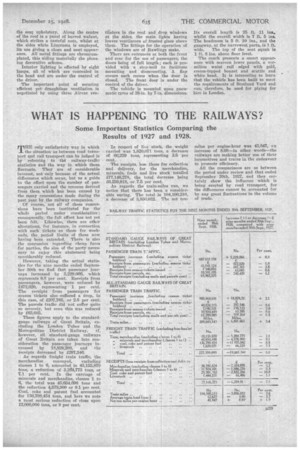• WHAT IS HAPPENING TO THE RAILWAYS?
Page 27

If you've noticed an error in this article please click here to report it so we can fix it.
Some Important Statistics Comparing the Results of 1927 and 1928.
Sr HE only satisfactory way in which
the' situation as between road transport and rail transport can be judged is by referring to thE railway-traffic statistics and the way in which these fluctuate. They are of considerable interest, not only because of the actual differences which occur, but as a guide to the effect upon the number of passengers carried and the revenue derived from them vhieh ha's been caused Ly the many concessions made during the past year by the railway companies.
Of couree, not all of these comessloes have been instituted for the whole period under consideration ; consequently,' the .full effect has not yet been felt. Likewise, there are other alterations, for instance, in connection with such tickets as those for weekends, the period limits of these now having been extended. There is also the concessien regarding cheap fares for parties, the size of the. party necessery to enjoy this abatement being considerably reduced.
However, taking the actual statistics for the. nine months ended September 30th we find that passenger journeys increased by 5,229,066, which represents 0.8 per cent. Receipts from passengers, however, were reduced by 1472,020, representing 1 per edit. The receipts from passengers for season tickets also suffered a drop, in this case, of £207,765, or 2.8 per cent. The parcels traffic did not suffer quite so severely, but even this was reduced by £63,685.
These figures apply to the standardgauge railways of Great Britain, excluding the London Tubes and the Metropolitan District Railway. if, however, all standard-gauge railways of Great Britain are taken into Consideration the passenger journeys • increased by 18,829,208, and the receipts decreased by £297,546.
As regards freight train traffic, the Merchandise conveyed, excluding classes 1 to 6, amounted to 43,155,870 tons, a reduction of 3,241,773 tons, or 7.1 per cent. In the carriage of minerals and merchandise classes 1 to
6, the total was 45;654,498 tons and the reduction 4,578,900 or 9.1 per cent. Coal, coke and patent fuel accounted for 136,708,454 tans, and here we note a most serious reduction of close upon 12,000,000 tons, or 8 per cent. In respect of live stock, the weight carried was 1,820,071 tons, a decrease cif 66,229 tons, representing 3.5 per cent.
The receipts, less those for collection and delivery, for the merchandise, minerals, fuels and live stock totalled 177,146,278, the total decrease being £6,259,918, or 7.5 per cent.
, As regards the train-miles run, we notice that there has been a considerable saving. The total is 104,100,210, a decrease of 3,856,032. The net ton
miles per engine-hour was 43,847, an increase of 8.09-in ether words-the railways are making better use of their locomotives and trains in the endeavour to promote efficiency.
All the comparisons are as between the period under review and that ended September 30th, 1927, and they certainly show the influence which is being exerted by road transport, for the differences cannot be accounted for by any great fluctuations-in the volume of trade.






























